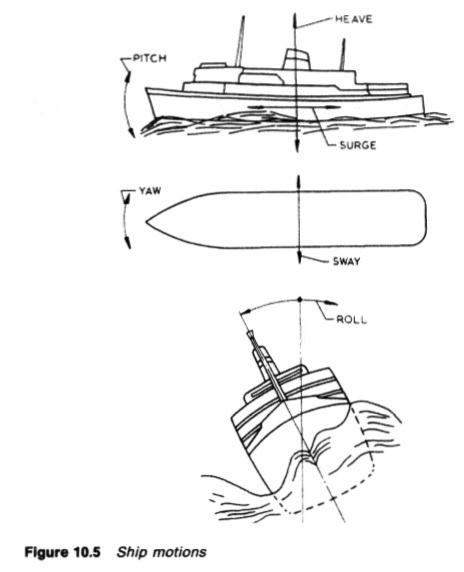
Home page||Cooling ||Machinery||Services ||Valves ||Pumps ||Auxiliary Power ||Propeller shaft ||Steering gears ||Ship stabilizers||Refrigeration||Air conditioning ||Deck machinery||Fire protection||Ship design
||
Ship stabilizers and stabilizing systems
Stabilizers and stabilizing systems
A ship at sea has six degrees of freedom, i.e. roll, heave, pitch, yaw, sway and
surge (Figure 10.5). Of these, only roll can effectively be reduced in practice by
fitting bilge keels, anti-rolling tanks or fin stabilizers. A combination of fins and tanks has potential advantages in prime cost and effective stabilization at both
high and low speeds.
Since a ship is a damped mass elastic system, it has a natural rolling period
and large rolling motions may be induced by resonance with relatively small
wave forces. Large resonant rolls can be avoided by generating forces equal
and opposite to the impressed sea force.
Figure 10.6 shows that the roll
amplitude at resonance is much greater than that at long wave periods. The
ratio of these amplitudes is the dynamic amplification factor which is limited by
the inherent damping of the ship, i.e. viscous damping and the action of bilge
keels.

Figure : Ship motions
Summarized below ship stabilizing system detail guideline:
- Ships bow thrusters-Electric drives, diesel drives, hydraulic drives & white Gill type
Safety is increased when berthing in adverse
weather conditions provided that the required thruster capacity has been
correctly estimated. Transverse thrusters are installed to facilitate the
positioning of some types of workboats.
More .....
- Fin stabilizers and stabilizing systems
The stabilizing power of fins is generated by their movement through the sea and lift' created by the flow of water above and below the 'aerofoil' or hydrofoil shape. When the front edge of the fin is tilted up, water flow across the top of the profile produces lift due to a drop in pressure while a lifting pressure is provided by flow along the underside.More.....
- Folding fin stabilizer & Retractable fin stabilizers-
Housing and extending the fin is achieved by a double acting hydraulic
cylinder connected to the upper part of the trunnion. Power units, control and
sensing equipment are generally similar to other types of stabilizer except that
feed-back of fin angle is accomplished electrically by synchros.More....
- Tank stabilizers
Tank stabilizers (like bilge keels) are virtually independent of the forward speed
of the vessel. They generate anti-rolling forces by phased flow of appropriate
masses of fluid, usually water, in tanks installed at suitable heights and distances
from the ship's centre line.More....
Home page||Cooling ||Machinery||Services ||Valves ||Pumps ||Auxiliary Power ||Propeller shaft ||Steering gears ||Ship stabilizers||Refrigeration||Air conditioning ||Deck machinery||Fire protection||Ship design
||Home ||
General Cargo Ship.com provide information on cargo ships various machinery systems -handling procedures, on board safety measures and some basic knowledge of cargo ships that might be useful for people working on board and those who working in the terminal. For any remarks please
Contact us
Copyright © 2010-2016 General Cargo Ship.com All rights reserved.
Terms and conditions of use
Read our privacy policy|| Home page||
